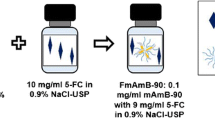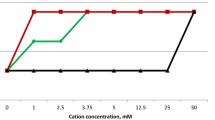Abstract
Purpose
Rapamycin and 5-fluorocytosine (5-FC) are antifungal agents with unique mechanisms of activity, with potential for cooperative interaction with AmB. Combination antifungal therapy involving conventional AmB has been restricted by poor physical stability and compatibility with antifungal drugs and vehicles.
Methods
AmB and rapamycin were encapsulated in 1,2-distearoyl-sn-glycero-3-phosphoethanolamine-N-methoxy poly(ethylene glycol) (PEG-DSPE) micelles using a solvent evaporation method. The physical stability of micelle encapsulated AmB and rapamycin with 5-FC and saline was evaluated using dynamic light scattering (DLS). In vitro susceptibility of Candida albicans isolates to 5-FC and PEG-DSPE micelle solubilized AmB and rapamycin has been evaluated. Interactive effects have been quantified using a checkerboard layout.
Results
In contrast with conventional AmB, PEG-DSPE micelles encapsulating AmB and rapamycin are compatible with saline and 5-FC over 12 h. The solubilized drugs retain high level of potency in vitro. The combination of solubilized AmB and rapamycin was indifferent, as fractional inhibitory concentration (FIC) index and combination index (CI) values were approximately 1. Combinations of solubilized AmB or rapamycin with 5-FC, and the three-drug combination were moderately synergistic since the FIC index and CI values were consistent less than 1.
Conclusions
These results indicate that AmB solubilized in PEG-DSPE micelles is compatible with solubilized rapamycin and 5-FC. The indifferent or moderately synergistic activity of combinations is encouraging and warrants further investigation in appropriate rodent models.






Similar content being viewed by others
References
O. Gudlaugsson, S. Gillespie, K. Lee, J. Vande Berg, J. Hu, S. Messer, L. Herwaldt, M. Pfaller, and D. Diekema. Attributable mortality of nosocomial candidemia, revisited. Clin. Infect. Dis. 37:1172–1177 (2003).
B. Spellberg, S. Filler, and J. Edwards. Current treatment strategies for disseminated candidiasis. Clin. Infect. Dis. 42:244–251 (2006).
B. Dupont. Overview of the lipid formulations of amphotericin B. J. Antimicrob. Chemother. 49(Suppl. 1):31–36 (2002).
T. Walsh, R. Finberg, C. Arndt, J. Hiemenz, C. Schwartz, D. Bodensteiner, P. Pappas, N. Seibel, R. Greenberg, S. Dummer, M. Schuster, J. Holcenberg, and W. Dismukes. Liposomal amphotericin B for empirical therapy in patients with persistent fever and neutropenia. N. Engl. J. Med. 340:764–771 (1999).
M. Johnson, C. Macdougall, L. Ostrosky-Zeichner, J. Perfect, and J. Rex. Combination antifungal therapy. Antimicrob. Agents Chemother. 48:693–715 (2004).
P. Mukherjee, D. Sheehan, C. Hitchcock, and M. Ghannoum. Combination treatment of invasive fungal infections. Clin. Microbiol. Rev. 18:163–194 (2005).
H. Kume, S. Murase, and M. Mochizuki. Combined effect of antifungal agents—Fundamental study on amphotericin B and flucytosine. Jpn. J. Med. Mycol. 26:126–132 (1985).
J. Sobel. Combination therapy for invasive mycoses: Evaluation of past clinical trial designs. Clin. Infect. Dis. 39(Suppl. 4):S224–S227 (2004).
J. Arroyo, G. Medoff, and G. Kobayashi. Therapy of murine aspergillosis with amphotericin B in combination with rifampin of 5-fluorocytosine. Antimicrob. Agents Chemother. 11:21–25 (1977).
D. Te Dorsthorst, P. Verweij, J. Meletiadis, M. Bergervoet, N. Punt, J. Meis, and J. Mouton. In vitro interaction of flucytosine combined with amphotericin B or fluconazole against thirty-five yeast isolates determined by both the fractional inhibitory concentration index and the response surface approach. Antimicrob. Agents Chemother. 46:2982–2989 (2002).
G. Medoff, G. Kobayashi, C. Kwan, D. Schlessinger, and P. Venkov. Potentiation of rifampicin and 5-fluorocytosine as antifungal antibiotics by amphotericin B (yeast-membrane permeability-ribosomal RNA-eukaryotic cell-synergism). Proc. Natl. Acad. Sci. 69:196–199 (1972).
W. Hope, P. Warn, A. Sharp, P. Reed, B. Keevil, A. Louie, D. Denning, and G. Drusano. Surface response modeling to examine the combination of amphotericin B deoxycholate and 5-fluorocytosine for treatment of invasive candidiasis. J. Infect. Dis. 192:673–680 (2005).
C. Vezina, A. Kudelski, and S. Sehgal. Rapamycin (AY-22,989), a new antifungal antibiotic I. Taxonomy of the producing streptomycete and isolation of the active principle. J. Antibiotics 28:721–726 (1975).
H. Baker, A. Sidorowicz, S. Sehgal, and C. Vezina. Rapamycin (AY-22,989), a new antifungal antibiotic III. In vitro and in vivo evaluation. J. Antibiotics 31:539–545 (1978).
B. Kahan, and J. Camardo. Rapamycin: Clinical results and future opportunities. Transplantation 72:1181–1193 (2001).
D. Dickman, H. Ding, Q. Li, A. Nilius, D. Balli, S. Ballaron, J. Trevillyan, M. Smith, L. Seif, L. Kim, A. Sarthy, R. Goldman, J. Plattner, and Y. Bennani. Antifungal rapamycin analogues with reduced immunosuppressive activity. Bioorg. Med. Chem. Lett. 10:1405–1408 (2000).
J. Rohde, J. Heitman, and M. Cardenas. The TOR kinases link nutrient sensing to cell growth. J. Biol. Chem. 276:9583–9586 (2001).
P. Simamora, J. Alvarez, and S. Yalkowsky. Solubilization of rapamycin. Int. J. Pharm. 213:25–29 (2001).
A. Imhof, R. Walter, and A. Schaffner. Continuous infusion of escalated doses of amphotericin B deoxycholate: An open-label observational study. Clin. Infect. Dis. 36:943–951 (2003).
U. Eriksson, B. Seifer, and A. Schaffner. Comparison of effects of amphotericin B deoxycholate infused over 4 to 24 hours: Randomized controlled trial. Br. Med. J. 322:579–582 (2001).
A. Peleg, and M. Woods. Continuous and 4 h infusion of amphotericin B: A comparative study involving high-risk haematology patients. J. Antimicrob. Chemother. 54:803–808 (2004).
R. Lewis, and N. Wiederhold. The solubility ceiling: a rationale for continuous infusion of amphotericin B therapy? Clin. Infect. Dis. 37:871–872 (2003).
A. Llanos, J. Cieza, and J. Berando. Effect of salt supplementation on amphotericin nephrotoxicity. Kidney Int. 40:302–308 (1991).
R. Jurgens, P. Deluca, and D. Papadimitriou. Compatibility of amphotericin B with certain large-volume parenterals. Am. J. Hospital Pharm. 38:377–378 (1981).
R. Vakil, and G. Kwon. PEG-phospholipid micelles for the delivery of amphotericin B. J. Control. Release 101:386–389 (2005).
R. Vakil, and G. Kwon. Effect of cholesterol on the release of amphotericin B from PEG-phospholipid micelles. Mol. Pharm. 5:98–104 (2007), DOI 10.1021/mp700081v.
R. Vakil, A. Kuldipkumar, D. Andes, Y. Tan, and G. Kwon. Polymeric micelles for the delivery of polyene antibiotics. In S. Svenson (ed.), Polymeric drug delivery Vol. I.—Particulate carriers, ACS Symposium Series, Vol. 923, New York, 2006, pp. 14–26.
M. Pfaller. Reference method for broth dilution antifungal susceptibility testing of yeasts: Approved standard. M27-A2, Vol. 22. National Committee for Clinical Laboratory Standards, Wayne, 2002.
T.-C. Chou, and P. Talalay. Quantitative analysis of dose–effect relationships: the combined effects of multiple drugs or enzyme inhibitors. Adv. Enzyme Regul. 22:27–55 (1984).
T.-C. Chou, and P. Talalay. Generalized equations for the analysis of inhibitions of Michaelis-Menten and higher-order kinetic systems with two or more mutually exclusive and nonexclusive inhibitors. Eur. J. Biochem. 115:207–216 (1981).
Instructions to Authors. Antimicrob. Agents Chemother. 50:1–21 (2006).
F. Odds. Synergy, antagonism, and what the chequerboard puts between them. J. Antimicrob. Chemother. 52:1 (2003).
T.-C. Chou. Theoretical basis, experimental design, and computerized simulation of synergism and antagonism in drug combination studies. Pharmacol. Rev. 58:621–681 (2006).
M. Espuelas, P. Legrand, M. Campanero, M. Appel, M. Cheron, C. Gamazo, G. Barratt, and J. Irache. Polymeric carriers for amphotericin B: In vitro activity, toxicity and therapeutic efficacy against systemic candidiasis in neutropenic mice. J. Antimicrob. Chemother. 52:419–427 (2003).
Z. Nakagawa, M. Nucci, M. Branchini, R. Salomao, R. Richtmann, and A. Colombo, A. In vitro susceptibility patterns of 200 recent bloodstream isolates of Candida species to four antifungal drugs determined by the NCCLS microbroth procedure. In Intersci. Conf. Antimicrob. Agents Chemother. (1998).
M. Ghannoum, M. Motawy, M. Abu Hatab, A. Ibrahim, and R. Criddle. Multifactorial analysis of effects of interactions among antifungal and antineoplastic drugs on inhibition of Candida albicans growth. Antimicrob. Agents Chemother. 33:717–725 (1989).
W. Greco, G. Bravo, and J. Parsons. The search for synergy: A critical review from a response surface perspective. Pharmacol. Rev. 47:331–385 (1995).
W. Greco, H. Park, and Y. Rustum. Application of a new approach for the quantitation of drug synergism to the combination of cis-diamminedichloroplatinum and 1-beta-d-arabinofuranosylcytosine. Cancer Res. 50:5318–5327 (1990).
W. Steinbach, W. Schell, J. Blankenship, C. Onyewu, J. Heitman, and J. Perfect. In vitro interactions between antifungals and immunosuppressants against Aspergillus fumigatus. Antimicrob. Agents Chemother. 48:1664–1669 (2004).
S. Shadomy, G. Wagner, E. Espinel-Ingroff, and B. Davis. In vitro studies with combinations of 5-fluorocytosine and amphotericin B. Antimicrob. Agents Chemother. 8:117–121 (1975).
M. Ghannoum, M. Motawy, M. Abu Hatab, K. Abu Elteen, and R. Criddle. Interactive effects of antifungal and antineoplastic agents on yeasts commonly prevalent in cancer patients. Antimicrob. Agents Chemother. 33:726–730 (1989).
Author information
Authors and Affiliations
Corresponding author
Rights and permissions
About this article
Cite this article
Vakil, R., Knilans, K., Andes, D. et al. Combination Antifungal Therapy Involving Amphotericin B, Rapamycin and 5-Fluorocytosine Using PEG-Phospholipid Micelles. Pharm Res 25, 2056–2064 (2008). https://doi.org/10.1007/s11095-008-9588-1
Received:
Accepted:
Published:
Issue Date:
DOI: https://doi.org/10.1007/s11095-008-9588-1




